One site detailed the procedure and listed
the materials that were used. The person used a two part High performance polyester
urethane from Forsch Polymer Corp. I called Forsch and told their technician exactly
what I wanted to do with their product, he told me their product has been used by
many people to rebuild motor mounts and recommended their medium durometer
high tear strength system, 60A with their ADH 1001 urethane to metal primer.
Click on a picture to bring up a larger image in a new window.
|
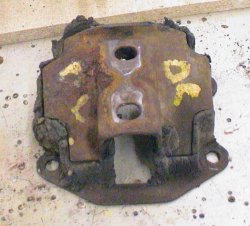
|
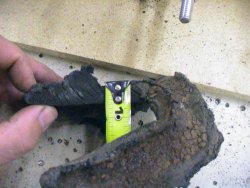
|
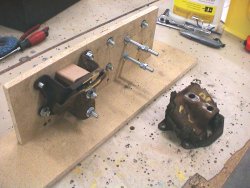
|
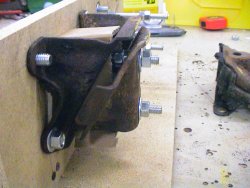
|
| This is one of my original motor mounts, it
rough shape, it was still stuck together, the other mount's rubber cushion fell
apart when I removed it from the car. I measured the cushion from the other mount
to determine the distance of separation of the two parts. I measured about an 1/2"
but figure I should add a little to compensate for compression over the last 70
years.
|
I made a jig/stand out of 1/2" particle board
to mount the mounts to. I measured the mounting holes of both the motor side and
the frame side and marked and drilled holes in the upright board. I recessed all
of the holes so I could fasten the bolts with a nut on the front, keeping the mounting
surface of the motor mount flush on the particle board. I used 3/8"x1 1/2" for the
motor side and 3/8" threaded rod and nuts to mount the frame side of the motor mount.
I used nuts to keep the two pieces separated the correct distance.
|
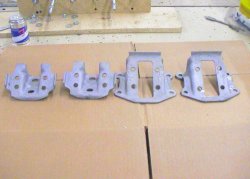
|
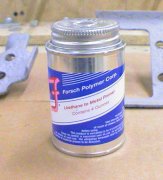
|
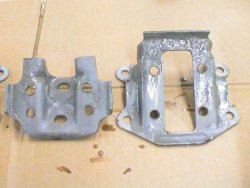
|
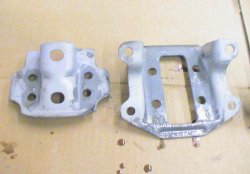
|
As per instructions, I sand blasted the parts so the polyester
urethane had a good, clean surface to bond to. The Forsch tech also suggested drilling
larger holds in both parts to assure a mechanical bond as well as an adhesion bond.
I applied the recommended primer. It brushes on wet but when dry it's almost invisible.
I covered all bonding surfaces, including the inside and areas around the holes I drilled.
|
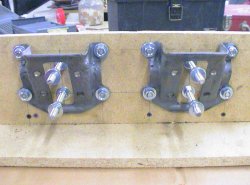
|
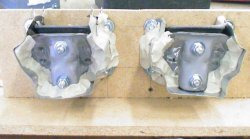
|
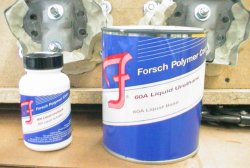
|
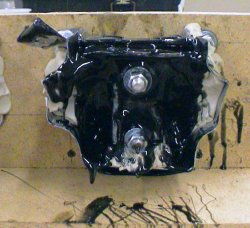
|
I bolted the mounts to the stand. I tried to
seal off the mounts the best I could so I wouldn't have a lot of spillage and wasted
product, I wasn't too successful. I figured one can of urethane should have been
enough for both mounts but ended up using one can for just one mount. I used a roll of
light weight 6" wide aluminum roof flashing and plumber's putty to seal the mounts. I was only
able to do one and it was a mess, for the second one I will do better. I also used
cardboard to seal the inside cavity of the mount, this is where all of my leakage occurred.
I lined the cardboard with plastic packing tape to prevent the urethane from sticking to
it, it worked pretty good. The flashing peeled off fairly easy without coating it.
|
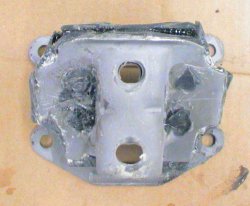
|
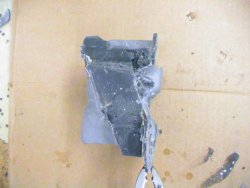
|
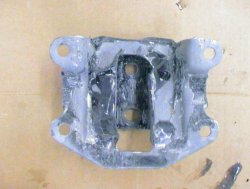
|
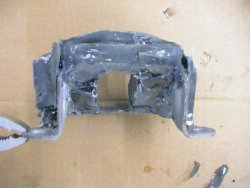
|
| Here are the results. Not very pretty but
they're going to be under the car getting greasy and dirty and no one will ever see
them. They'll also look a lot better with a coat of black paint on them.
I had to do some trimming of the urethane and had a little difficulty
separating the mount from the stand but it wasn't all that hard. Well worth the
$150 savings and being able to say I was able to do another job on my car myself.
|
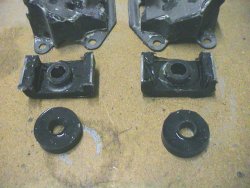
|
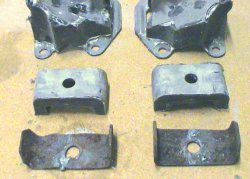
|
| I recently cast the remaining rear mount and the
bottom and top parts of the front mounts.
|
Because the front mount trays were pretty beat up
I built new ones.
|
| Total cost for the entire project: |
2 urethane kits 
Way more than enough to do
all the parts, as long
you're able to dam the parts properly. |
$70 |
Urethane primer 
One can is more than enough for
at least 6 urethane kits |
$12 |
Shipping
(for both kits, two shipments) |
$10 |
Misc. Hardware
(nuts, bolts, washers) |
$2 |
| Plumbers putty (for damming) |
$2 |
| Paint |
$5 |
| Solvents |
$5 |
| Total |
$106 |
| Total time for the entire project: |
| Blast parts |
2 hours |
| Built fixtures |
2 hours |
| Set up parts |
2 hours |
| Mix and Pour urethane |
1 hour |
| Clean excess urethane from parts |
1 hour |
| Paint parts |
1 hour |
| Total estimated time |
9 hours |
|
| Total cost to have mounts rebuilt and new
parts: |
| Cost to have rear rebuilt |
$170-200 |
| New front mounts |
$70.00 |
| Front donuts |
$13.50 |
Shipping
(including two way for rear mounts) |
$30-40 |
| Total |
(roughly) $240-325 |
| Total time for the entire project: |
Order parts over phone |
1/2 hour |
Find box and box up parts |
1 hour |
| Send parts off and wait for return |
3-4 Weeks |
| Total estimated time |
1 1/2 hour
plus3-4 weeks |
|
|
|

